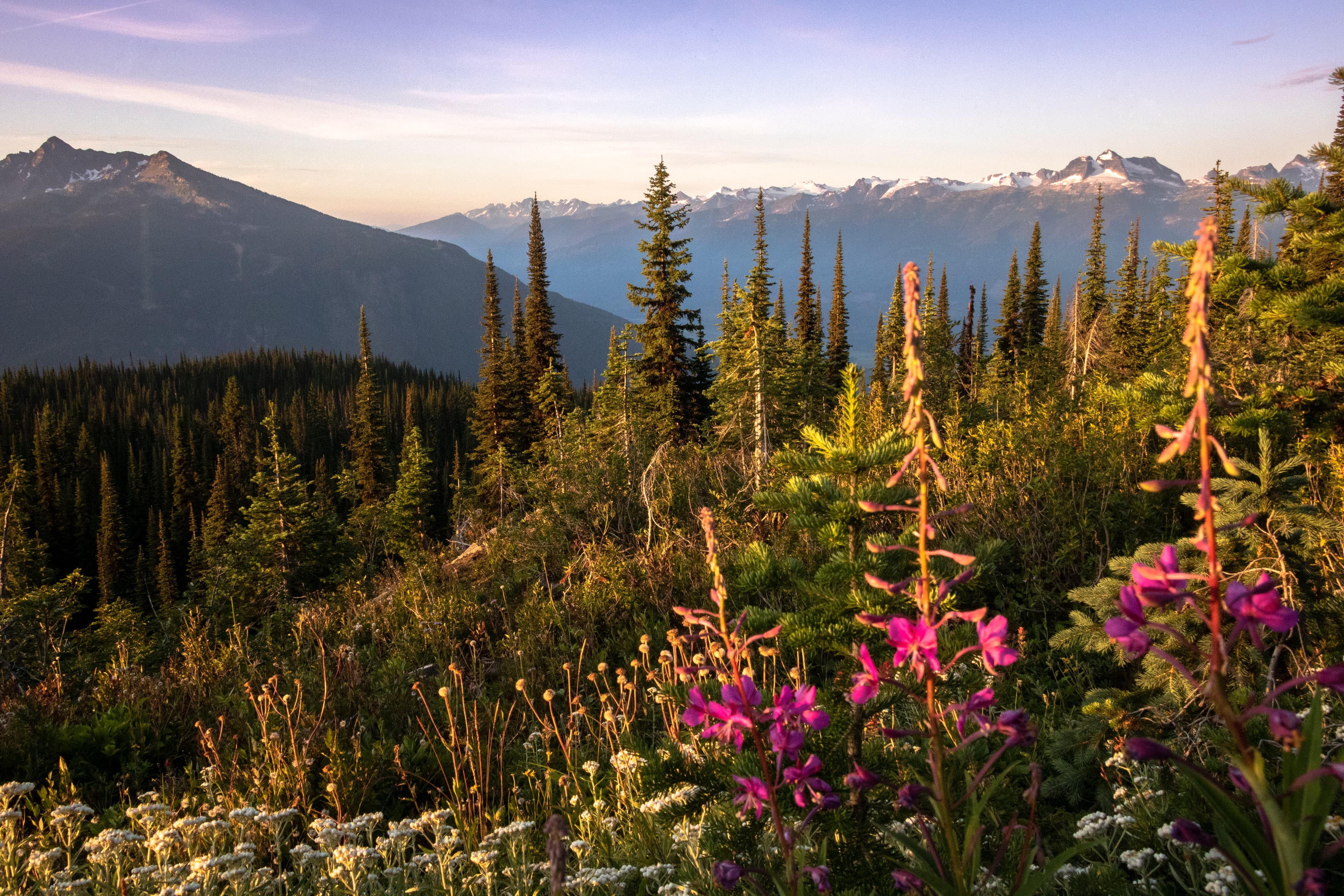Find wildflowers and identify them.
While Revelstoke's mountain scenery is spectacular year-round, there's nothing quite like seeing it at the peak of wildflower season. Vibrant yellow, red, purple, and green wildflowers bring the alpine to life in July and August. As the days warm up, flowers slowly climb up the mountains and can be found at various elevations depending on the snow melt.
The Best Time To Find Them?
The best time to see wildflowers in Revelstoke is in July and August. The previous winter season's snowpack determines the peak bloom. If the snow melts slowly in the alpine during spring, wildflowers often peak in the first week of August. If there is less than average snowfall during winter, wildflowers may bloom sooner.
Wildflower Id
Identify Revelstoke's native wildflowers. There’s nothing worse than thinking you have taken the most perfect photo of the alpine blooms, only to realize that it’s an invasive species that has stolen the habitat of native wildflowers.

Paintbrush
Castilleja miniata
Paintbrushes are one of the most recognisable flowers you can find in a subalpine meadow. Hummingbirds rely on this plant for food and are attracted to the red flowers. Although this plant gets energy from photosynthesis, it also steals energy from other plants by attaching to their roots.

Arctic Lupin
Lupinus arcticus
Arctic lupine carpets Mount Revelstoke’s alpine meadows with purple. Once the flowers are pollinated, the seeds develop into pods. When dry, the pods burst open and spread their seeds outward. No wonder lupines are so bountiful!

Sub-Alpine Daisy
Erigeron peregrinus
Another subalpine species, this star-shaped flower is often mixed with lupines, paintbrushes, and arnica. This plant decreases in size as you get to higher elevations. People commonly mix up this plant and the invasive oxeye daisy so look for the purple petals.

Sitka valerian
Valeriana sitchensis
This shapeshifting plant starts with red shoots and pink flowers. This helps protect it from the sun. As the plant gets older, it begins to turn white and after the first frost in the fall, it gives off a sour, skunk-like odor!

Glacier Lily
Erythronium grandiflorum
These are some of the first flowers you will see in the subalpine during snowmelt . They are a common snack for Grizzly bears who enjoy their bulbous roots. Glacier lily bulbs were also traditionally an important source of carbohydrates for Indigenous peoples.

Western Anemone
Anemone occidentalis
Once these flowers go to seed, they become an iconic part of the alpine wildflower display. Their interesting appearance has earned them many funny names including "mop-tops," "hippy heads", and some think they were the inspiration for Dr Seuss’ “truffula trees”.

White Mountain Heather
Cassiope mertensiana
One of the cutest flowers you can find! This plant has done an excellent job of creating the perfect fruit bearing environment. The bell-shaped flowers allow light in, trap heat, and offer protection from wind. This creates the extra energy the plant needs to produce fruit.

Moss Campion
Silene acaulis
A low, ground-hugging plant with delicate flowers best appreciated up close. Moss champion is very slow-growing in the alpine, due to the challenging environment. By 25 years old, it is only about 8" wide. Be careful where you step!

Fireweed
Chamaenerion angustifolium
Fireweed is often found in cool, mountainous terrain, and despite its name, is a native wildflower in Canada. It thrives in open forests, burned sites, and along riverbanks. It is a key species in forest regeneration. Indigenous peoples utilized fireweed for food, weaving, plant medicines, and more.

Willowherb
Chamerion latifolium
Willowherb is closely related to fireweed and is sometimes called river-beauty, as it can often be found growing in the sand or gravel along rivers. This flower is well adapted to living in cold alpine and arctic environments. It is also the national flower of Greenland!
Where to find wildflowers

Mount Revelstoke National Park
Home to the Meadows in the Sky Parkway, a 26km paved road to the summit of Mount Revelstoke. A great spot for camping, hiking, snowshoeing, mountain biking, and sightseeing, located just 5 minutes from downtown Revelstoke.

Glacier National Park
A world-renowned outdoor mecca, famed for its alpine hiking and backcountry touring, scenic views, and old-growth forests. Located on Hwy 1 in between Golden and Revelstoke.

Revelstoke Mountain Resort
Revelstoke Mountain Resort is a ski resort on Mount Mackenzie, just outside Revelstoke, British Columbia, Canada. The Resort boasts 3121 acres of skiing terrain, wide-open bowls, glades for days & flowy groomers.
Trail Recommendations.
Located next to Mount Revelstoke and Glacier National Parks, Revelstoke is the perfect base for hiking in the alpine.
Easy Hike: Balsam Lake in Mount Revelstoke National Park.
Moderate Hike: Eva Lake Trail in Mount Revelstoke National Park.
Challenging Hike: Hermit Trail in Glacier National Park.
Sightseeing: Split Rock Falls at Revelstoke Mountain Resort

Wildflowers, Glacier National Park | P Vincent Schnabl
Alpine Biking Recommendations.
If you like to pedal, hit up Frisby Ridge or Keystone Standard Basin for the ultimate wildflower rides.
You will zig and zag through alpine meadows and experience stunning views of the valley below. Both of these trails are 700 m+ elevation climbs & not for the faint of heart. E-bikes are allowed on both of these trails if you love some pedal assist!
If downhill is more your thing, get a shuttle to Martha Creek Downhill trailhead or enjoy lift-accessed trails at Revelstoke Mountain Resort.

Frisby Ridge | P Shota Ida



The Real Stoke
Fuel Your Fire Within.
Experience #TheRealStoke for yourself.


